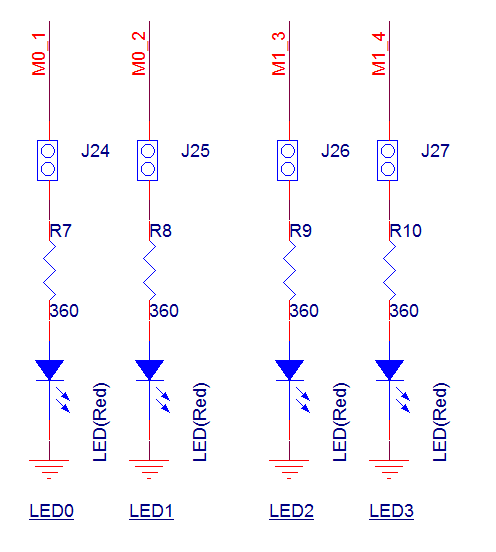Output Toggle
该示例基于 GPIO 的输出功能,实现 LED 的周期性状态翻转控制。
需要将 GPIO 配置为输出模式。在 while 循环内,每 1s 翻转输入电平,以驱动 LED 闪烁。
用户可以通过不同的宏配置来修改引脚信息。具体宏配置详见 配置选项。
环境需求
该示例的环境需求,可参考 环境需求。
硬件连线
连接 P1_0 和 LED0。 LED 驱动电路如下图所示。

LED 驱动电路图
配置选项
-
可配置如下宏修改引脚定义。
#define OUTPUT_PIN P1_0
编译和下载
该示例的编译和下载流程,可参考 编译和下载。
测试验证
-
当 EVB 启动后,在 Debug Analyzer 工具内观察如下 log。
Start gpio toggle test!
观察 LED 灯闪烁情况。
代码介绍
该章节主要介绍示例中的初始化和相应功能实现的代码和流程说明。
源码路径
工程文件和源码路径如下:
工程路径:
sdk\samples\peripheral\gpio\output_toggle\proj源码路径:
sdk\samples\peripheral\gpio\output_toggle\src
初始化
外设的初始化流程可参考 General Introduction 中的 初始化流程 部分。
-
调用
Pad_Config()与Pinmux_Config(),配置对应引脚的 PAD 和 PINMUX 。void board_gpio_init(void) { Pad_Config(OUTPUT_PIN, PAD_PINMUX_MODE, PAD_IS_PWRON, PAD_PULL_NONE, PAD_OUT_ENABLE, PAD_OUT_HIGH); Pinmux_Config(OUTPUT_PIN, DWGPIO); }
调用
RCC_PeriphClockCmd(),开启 GPIO 时钟。-
对 GPIO 外设进行初始化:
定义
GPIO_InitTypeDef类型GPIO_InitStruct,调用GPIO_StructInit()将GPIO_InitStruct预填默认值。根据需求修改
GPIO_InitStruct参数,GPIO 的初始化参数配置如下表。调用GPIO_Init(),初始化 GPIO 外设。
GPIO Hardware Parameters |
Setting in the |
GPIO |
|---|---|---|
GPIO pin |
|
|
GPIO direction |
||
GPIO interrupt |
功能实现
初始化后执行 while 循环,循环体内调用 GPIO_WriteBit() 函数,控制 GPIO 输出高低电平。
while (1)
{
/* Set GPIO_PIN_OUTPUT */
GPIO_WriteBit(GPIO_PORT, GPIO_PIN, (BitAction)(1));
platform_delay_ms(1000);
/* Reset GPIO_PIN_OUTPUT */
GPIO_WriteBit(GPIO_PORT, GPIO_PIN, (BitAction)(0));
platform_delay_ms(1000);
}
See Also
相关 API Reference 请查看: